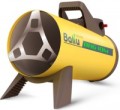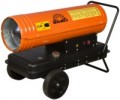Power supply
The source of energy needed to operate the industrial heater.
—
Electric. Industrial heaters with electric heaters are fan heaters with increased power. They are relatively small in size and weight, easy to move from place to place (compared to models using other types of power supply), relatively quiet, do not require a supply of fuel and do not create exhaust gases during operation. Electricity is inexpensive and available almost everywhere. On the other hand, such heaters still cannot be used autonomously — in the absence of power grids (or independent sources of electricity like diesel generators), they become useless. Also, such units have relatively low power, while the load on the power grid during their operation is very significant, which puts forward certain requirements for connection and makes long-term work difficult. And for conditions of high humidity, electric models are poorly suited (more precisely, they are not recommended at all).
—
Gas. Gas industrial heaters have high power with small size and weight, as well as, low cost. During operation, they require ventilation to remove combustion products. However, harmful compounds in these products are still much less than during the operation of a diesel unit (see below). The main disadvantage of this option is the difficulty in supplying fuel: this requires either a gas line or a supply of gas in cylinders. The first opt
...ion is not available everywhere, and the second is associated with certain difficulties because there are several requirements for the transportation and storage of gas cylinders. In addition, at low temperatures, such heaters may lose power, and even under normal conditions, a certain gas pressure is required for normal operation (see below).
— Diesel. The name of this type is because such units use diesel fuel as a power source; however, many can also run on kerosene. Diesel industrial heaters have high power, and while they are much better than gas ones, they are suitable for autonomous use — liquid fuel is safer than gas, it is not difficult to stock up on them in advance, and you don’t have to worry about ensuring working pressure. However, many models also require electricity — but it is used exclusively for fans and control circuits, and the power consumption of a diesel heater is orders of magnitude lower than that of an electric one. On the other hand, the units are much more complicated, heavier and more expensive, because the design should include a tank and a fuel supply system, and they require more maintenance. Another serious problem is the exhaust gases generated during the combustion process: because of them, such devices cannot be used in rooms without ventilation or chimneys (depending on the type of diesel heater, see below for more details).
— Water circuit. Industrial heaters with such a power supply are actually heating radiators, supplemented with fans to ensure air circulation. The source of heating in such devices is a heat exchanger through which hot water passes from a heating boiler or other source of energy. Thus, models with a water circuit, unlike the types described above, are poorly suited for frequent movements and are designed mainly for permanent installation in one place. In particular, such a unit can be a perfect option for large rooms that are heated from time to time, but you need to warm up the space quickly when you turn on the heating. At the same time, the key advantage of water industrial heaters is the minimum energy consumption: in fact, they do not consume energy, but only effectively distribute the heat that would have been used for heating anyway.Diesel exhaust type
This parameter describes the operation of the diesel heater(see "Power supply").
—
Direct heating. Direct heating assumes that the heated air passes directly through the combustion chamber and is blown out along with the exhaust gases. It significantly limits the scope of application: only non-residential premises with good ventilation can be heated with such heaters, and even if these conditions are met, being inside after heating can be quite uncomfortable. On the other hand, this scheme of operation is characterized by high efficiency — after all, all the generated heat goes directly to heating.
—
Indirect heating. The design of indirectly heated diesel heaters includes a closed combustion chamber equipped with a
heat exchanger and a flue. During the operation of the device, the air does not come into contact with the contents of the combustion chamber, but with the heat exchanger, and is not polluted by exhaust gases — they exit through a chimney that can be taken outside the room. Thanks to this, units with indirect heating are more convenient and not as limited in use as direct heating ones. Their disadvantages are complexity, high cost and somewhat reduced efficiency.
Note that in addition to these options, there is a separate type of diesel heaters — models with heaters in the form of IR plates. They do not have fans at all, and the
...division into direct and indirect is irrelevant to them; see "Heating element" for details.Max. thermal output
The highest heating power produced by an industrial heater.
The maximum area that the unit can effectively heat directly depends on this parameter (see below). Even if it is not indicated in the specs, it can be approximately determined from the calculation that for heating 1 m² of a room with a standard ceiling height of 2.5 m and good thermal insulation will require 100 W of thermal power. If the ceiling height is significantly different, then the power required for heating can already be withdrawn from the volume of the room — every 2.5 cubic metres of volume will require the same 100 W (and the volume is found by multiplying the area by the height of the ceiling). There are also more complex formulas for the most accurate calculation, taking into account the degree of thermal insulation, the temperature difference between inside and outside the room, etc.; they can be found in special sources.
Note that in electric models (see "Power supply"), the maximum thermal power, in addition to all of the above, also determines the total power consumption of the unit: the power consumption (see below) cannot be less than the thermal output (usually, it is somewhat higher due to for the removal of part of the energy for the operation of the fan). In devices with a water circuit, the actual thermal output depends on the temperature of the coolant at the inlet and outlet. Therefore, in the characteristics, a certain standard value is usually indicated, and in t...he notes, it is specified for which temperatures it is relevant (for example, 90 ° / 70 °).
Max. heating area
A very conditional parameter that slightly characterizes the purpose by the size of the room. And depending on the height of the ceilings, the layout of the room and the equipment, the actual values may differ significantly. Nevertheless, this item represents the maximum recommended area that the heat gun can effectively heat.
When determining the maximum area, usually, a universal formula is used that is valid for all heaters: 1 m² of floor space in a room with a standard ceiling height of 2.5 m requires 100 W of thermal power. Therefore, if the ceiling height differs markedly from this value, the actual heating area should be recalculated; for more details on scaling, see “Maximum thermal output".
Rated current
The current consumed by the heat gun during normal operation. This parameter is useful primarily for assessing the load on the mains that occurs during the operation of the unit and organizing the appropriate connection. In particular, the rated current of the fuse installed in the connection circuit cannot be lower than the total rated current of the connected load — otherwise, the power will be turned off. Heat guns (primarily electric, see "Power supply") are quite high consumption consumers in terms of current.
Power consumption
The power consumed by the electrical components of the industrial heater during operation.
This parameter allows, first of all, to assess the load on the power grid and the suitability of the available power for the normal operation of the unit. It is relevant for all types of modern industrial heaters (see "Power supply"). However, it is worth noting that in some electric models, the power consumption is indicated for the ventilation mode. In this mode, the heating element is not activated, and the power consumption is extremely low — a few tens of watts. In such cases, the total power can be estimated from the maximum thermal output (see above) — in electrical models, these parameters practically do not differ from each other.
Airflow
The maximum amount of air that an industrial heater can pass through itself in a certain time.
This parameter is associated with an increase in air temperature (see above): at constant power, higher performance usually corresponds to a smaller temperature difference. Accordingly, a more efficient industrial heater will heat the entire volume of the room faster, but the heating temperature will be lower. So, it is worth choosing according to this parameter, taking into account what is more important for you — a large temperature difference or a high heating rate.
Gas pressure
Gas pressure for which the gas industrial heater is designed (see "Power supply").
The pressure in the gas pipeline or at the outlet of the cylinder to which the unit is connected must correspond to this parameter as much as possible. If the pressure is too low, the gun may either not give out the required thermal output, or not start at all, and increased pressure is fraught with damage to the device and even injuries to others. Permissible deviations in working pressure for each model are different, this point should be clarified according to the manufacturer's official data.
Fuel tank volume
The volume of the fuel tank provided in the design of the diesel industrial heater (see "Power supply").
Other things being equal (primarily with the same fuel consumption), a larger tank allows the unit to work longer without refuelling. On the other hand, an increase in volume requires an increase in the dimensions and weight of the entire device. Knowing the maximum fuel consumption (see below), you can determine the guaranteed time of operation of the heater on a single refill. This time is often less than the maximum; see "Maximum operating time" for details.

